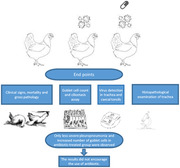- Record: found
- Abstract: found
- Article: found
Effect of enrofloxacin on clinical parameters and mucociliary system of broilers challenged with H9N2 avian influenza/infectious bronchitis viruses

Read this article at
Abstract
Background
Effect of antibacterials on mucociliary system and clinical outcome of chickens with mixed viral respiratory conditions is not properly addressed.
Objective
We evaluated enrofloxacin effects on clinical parameters and mucociliary system of broilers challenged with H9N2/IB viruses.
Methods
Broilers (105), at the age of 25 days, were randomly allocated into three groups: Group 1 (negative control), no treatment; Group 2 (positive control [PC]) challenged by intranasal and intraocular route. Group 3 (antibiotic [AB]‐treated) challenged and also received enrofloxacin started after manifestation of clinical signs (day 2 post‐challenge [pc]) and continued for 5 days.
Results
Administration of AB was not associated with appreciable changes in body weight, feed conversion ratio (FCR) or the severity of clinical signs although it slightly reduced mortality rate as compared to PC group ( p > 0.05). Virus shedding period and number of virus positive tracheal and caecal tonsil samples were also statistically similar between PC and AB groups. In necropsy, the most profound effect of AB was decreased pleuropneumonia severity score on day 12 pc. Histopathological lesion scores were statistically the same between PC and AB groups. However, the administration of AB increased the number of tracheal goblet cells, with no effect on ciliostasis.
Abstract
We found a weak positive effect of enrofloxacin administration in H9N2/IB‐infected chickens. Considering the risks of antibiotic treatment in broiler chickens, the results of this small‐scale study do not encourage the benefit of enrofloxacin use in these viral diseases, although performing future risk–benefit balance studies on a large number of birds and for longer periods following infection is suggested.
Related collections
Most cited references29
- Record: found
- Abstract: found
- Article: not found
Identification and subtyping of avian influenza viruses by reverse transcription-PCR.
- Record: found
- Abstract: found
- Article: not found
Evaluation of pathogenic potential of avian influenza virus serotype H9N2 in chickens.

- Record: found
- Abstract: found
- Article: found
